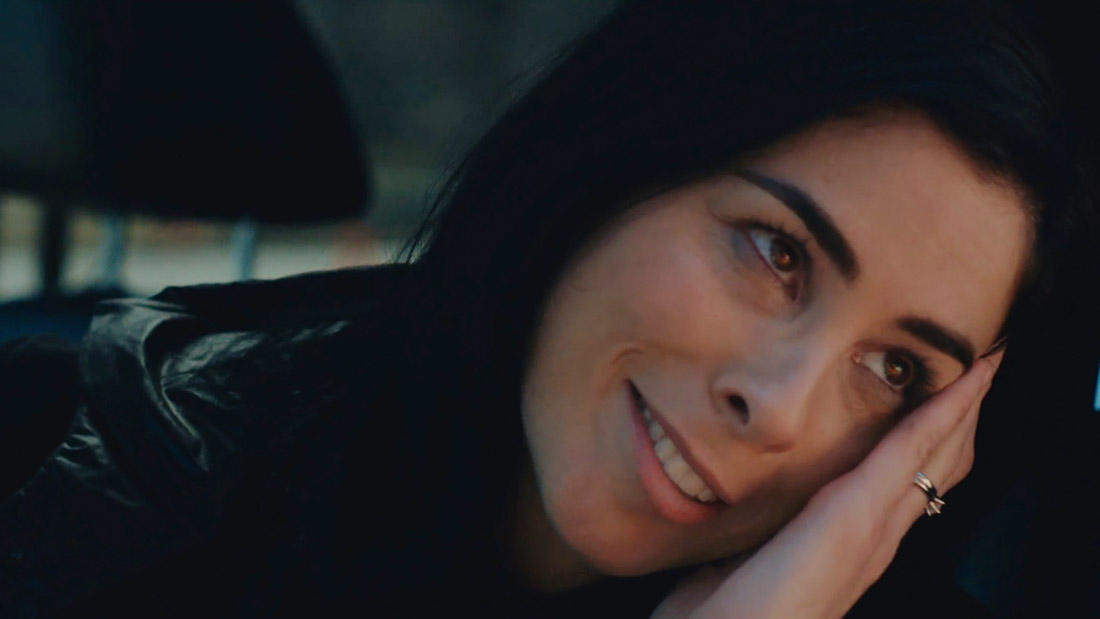“I Smile Back”
Sundance Institute
Sundance.org is dispatching its writers to daily screenings and events to capture the 10 days of festivities during the Sundance Film Festival in Park City, Utah. Check back each morning for roundups from the previous day’s events.
I Smile Back
by Eric Hynes
Sarah Silverman has built a career on confidence—on being the smartest, funniest, and most brazen person in the room. But after the unveiling of her career-turning, soul-baring dramatic performance in I Smile Back, which premiered on Sunday night at the Library Theater, she seemed utterly disoriented in front of the appreciative crowd. “Weird,” she intoned into the microphone, then tried to hide behind director Adam Salky.
In the film, she plays Laney, a suburban woman with two adorable children and a successful husband, who nevertheless suffers from depression and addiction. At first she manages to cover most of her tracks, but ultimately spirals into a dangerous maelstrom of alcohol, drugs, sexual promiscuity, rage and self-destruction. She rehabilitates at an addiction treatment center, and tries to reconcile with her estranged father, but struggled to readapt to normal life.

©Sundance Institute | Brandon Joseph Baker
Silverman spoke of how she came to play the part. “I wasn’t looking for this, but it came to me. Amy [Koppelman, author and co-screenwriter] heard me on Howard Stern and decided I was Laney, and got in touch with my agent, who loved her book, and forced me to read it. And it’s hard for me to read—I had to learn how to read first,” she said, drawing laughter from the crowd. “And I thought it was beautiful and I didn’t know if I liked her or not, but I liked how complicated it was. And they wrote a script of the book, and then they let me play it. And why wouldn’t I? What am I, busy? Why wouldn’t I do something so different where I’m unable to use any of my myriad bag of tricks?” Seemingly catching herself for slipping into a comedic routine, she then confessed, “I feel such pressure to entertain.”
In the post-screening discussion, Silverman, along with Salky, Koppelman, and co-screenwriter Paige Dylan discussed Laney’s questionable likeability, and the value of that ambiguity. “I understand seeing her sympathetically, and I understand seeing her like, fuck you, we’ve all had to survive things from childhood. And that’s what I like about it. That how you like Laney is going to be subjective and depend on your lives, and that’s interesting to me. We can fight about if she’s likable or not because we’re talking from our own little selves and life experiences.”
As for how Silverman’s own experiences filtered into her portrayal of Laney, she offered a story about her personal sensitivities. “My mother sent me a link, and the subject line said, ‘Elephants Reunite After 20 years.’ Now I’m sure it was really beautiful and a happy video, but I didn’t watch it. Because my heart can’t take it. As well as most Pixar movies. There are certain kinds of beauty that, for someone who might be kind of depressive, it’s too much.”
And when asked if working on I Smile Back was cathartic, she replied, “No, it hurt. But I’m really glad I did it. And came through the other side.” And though she wavered between being caustic and confessional during the Q&A, she admitted that the two are actually very related. “Comedy I feel is very vulnerable and exposing, and this was both of those things but on the other side of the coin. It was something I’d not experienced before,” she said.
Me and Earl and the Dying Girl
by Jeremy Kinser
Introducing Alfonso Gomez-Rejon’s Me and Earl and the Dying Girl, Sundance Festival Director John Cooper described the film as the kind programmers are always hoping for. “The one that sets the bar for everything else that’s going to happen,” he added, in what would prove to be an understatement.
Gomez-Rejon has directed numerous episodes of TV series such as American Horror Story and Glee, in which his virtuoso camera work has made him a standout talent on the small screen. However, nothing on his resume quite prepares one for his achievement with Me and Earl, which premiered in the U.S. Dramatic Competition at the Eccles Sunday to tremendous applause and quickly launched a record-shattering bidding war for distribution.

©Sundance Institute | Calvin Knight
The story follows Greg Gaines (Thomas Mann), a witty high school outcast who is forced to spend time with Rachel (Olivia Cooke), a girl he barely knows who is dying of leukemia. The title of the film, based on a novel by Jesse Andrews who also adapted it into the screenplay, sets up viewers for a tearjerker, which it is, but the film also delivers as a skillful character-driven comedy that wears its love of cinema on its sleeve (Greg is also an aspiring filmmaker who creates his own clever versions of cinema classics). It’s to the credit of both Gomez-Rejon and Andrews that the film never feels sentimental (there’s no romance between Greg and Rachel) or false and earns both its tears and laughter.
The director said he took on the project “for personal reasons and to process stuff that I’d gone through and come out the other end like Greg.” A credit dedicates the film to Gomez-Rejon’s late father. Gomez-Rejon told the Eccles crowd how important the Sundance premiere was to him. “I’ve been obsessed with movies since I saw my first one,” he said. “I’ve always dreamed of making a film that would premiere at the Sundance Film Festival so the fact that I’m here is overwhelming.” The director gave credit to his cast and crew and Andrews’ script.
“There was so much love on this set,” he said. “I’ve never felt anything like it. I hope you feel some of that love, too.” The audience shared the sentiment, giving the film a nearly five-minute-long standing ovation, with many still dabbing tears from their eyes and leaping to their feet before the lights came up.
Gomez-Rejon, who admitted he was very emotional following the film’s rapturous reception, credited his casting director for helping him find the ideal cast, which included vets Nick Offerman, Connie Britton and Molly Shannon.
Mann said he related to the character. “Sometimes you read something that sounds like you,” he shared. “I just saw a lot of myself in him and knew it was something I wanted to do.”
Cooke said she didn’t approach her character as a victim and that her illness was just an aside. “When I read the script I’d have done anything to be in it,” she admitted. Chemistry between the two leads was key to the film’s success, the director said. “They had to be just right,” he added. “If it was too much, it would be a love story. It had to be just this intense connection and acceptance.”
The Wolfpack
by Jeremy Kinser
A stranger-than-fiction documentary, The Wolfpack reveals the almost unbelievable story of the Angulo family. They’re seven children — six brothers and one sister, all with waist-length black hair — who are being raised on welfare in a crowded, untidy apartment on Manhattan’s Lower East Side. The surprise here is that they weren’t allowed to leave for 17 years due to their Hare Krishna father’s fear of the outside world. Crystal Moselle’s film, which premiered at the Temple Theatre in the U.S. Documentary Competition, isn’t a postmillennial Grey Gardens. Although the siblings are essentially shut-ins, they’re made aware of the world outside them through their intense love of movies.
Moselle began filming the boys in 2010 when they ranged in age from about 11 to 18. Articulate and likable, they’re being homeschooled by their mother (a hippie who grew up on a farm in the Midwest), but with no friends besides each other, the boys cope with their isolation by recreating their favorite movies, which include Batman movies and Quentin Tarantino films. Eventually, their curiosity about the outside demands satisfaction.

Moselle. ©Sundance Institute | Chris Evans
Moselle documents their attempts to ease into the city around them. She records their excitement at seeing their first film in a movie theater and their trepidation at stepping into the water while visiting a beach. Late in the film she introduces the boys’ father Oscar, but viewers never get a clear sense of what’s motivated him to hide his sons from the world. Moselle also doesn’t interview any of their neighbors or social workers (one of the teens is arrested, not for any wrongdoing but for freaking people while wandering the street dressed as Jason from Friday the 13th) to provide further insight.
Still, The Wolfpack offers an intriguing glimpse into the nature of establishing one’s identity and creativity with an introduction to one of the most unusual families you’re likely to meet, even if the film raises more questions than it satisfactorily answers. Perhaps sensing this, during the Q&A that followed the screening, the moderator asked the audience to keep their questions positive so most focused on the craft of the film and the brothers’ home movies.
Moselle says she befriended the brothers during one of their earliest ventures away from their home. “I feel so honored to have met these boys in the street that day,” Moselle said before the screening. “I was walking down the street and I saw this boy with long hair run past me and something about him intrigued me,“ she recalled. “Then another ran past and then another.”
When Moselle approached them they told her they’re not supposed to talk to strangers. The boys were intrigued to learn that Moselle is a filmmaker and told her that they want to get into the business.
When the Angulo brothers took the stage after the screening, their obsession with film was still evident as they were dressed in Reservoir Dogs-style black suits and sunglasses. The boys, who were enthusiastic discussing their home movie reenactments, also shared their current occupations, which include film production, activism and teaching yoga.
Western
by Eric Hynes
With its named derived from the classic 1970s outlaw movie, the Sundance Film Festival has always been fertile ground for fresh takes on the Western genre. But I’m not sure Park City has ever seen a Western like this one.
In Western, sibling director duo Bill and Turner Ross fashioned a frontier tale for our times not from the Hollywood handbook, but from the substance of real life. From 2010 to 2011, the brothers lived in Eagle Pass, Texas, which is directly across the border from Piedras Negras, Mexico, capturing the lives of the people and their culture, and crafting it into a work of nonfiction unlike any other. Rather than focus on issues or interviews or statistics, Western patiently observes an endangered way of life, and fashions these observations into indelible images, lyrical passages, and pungently metaphoric riffs on a genre that imbues the consciousness of the region as much as it does the Ross’s vision of it.

Azikiwe Aboagye
“As young kids we would go and see these B-westerns at a rerun theater with our dad, and it built up this mythology of the lawman and the cowboy, those landscapes, those big skies,” Turner Ross said during the post-screening Q&A. “We wanted to confront the mythic American landscape and the genre of the Western. We wanted to make a nonfiction Western.” But they also didn’t want to tell a story familiar to the one told on the nightly news, one that dwells entirely on immigration patrol and drug violence. “We wanted to see what the modern frontier really looks like. Beyond the one-dimensional news stories—because that’s not the way that everybody experiences it,” he said.
One of the fallacies that the film redresses is any notion of rancor or great difference between the two communities. People have long moved often and freely across the border, and Western shows two towns largely in harmony, with shared customs. “These are inexorably tied peoples. It’s not Texas and Mexico—it’s the border. It’s a region with its own history and culture,” Turner Ross said.
After following numerous people over 13 months of shooting, the Ross’s wound up crafting a film that focuses on two main characters—Chad Foster, the righteous mayor of Eagle Pass, and Martìn Wall, a fifth-generation cattleman. “Because we are relying on realism, on life, you can only get what comes to you. If it’s not scripted, then you have to rely on the world to give it to you,” Turner Ross said. “So we cast a very large net. We probably had a dozen people that we followed, and in the end it’s only two. You might see those people’s faces throughout the film, but in the end those stories either weren’t fully realized or they weren’t conducive to the story we were trying to tell. And in the end, Chad and Martìn sort of represent the poles of the story and two classic archetypes—Martìn as our cattleman, and Mayor Chad Foster as our John Wayne.”
10 Days of Independence
We’re celebrating 10 Days of Independence at the Sundance Film Festival with 10 Sundance Institute Members. Check the Daily Roundup to meet a new member each day and find out what they’re here to see, what they’re talking about and what Sundance film character they want to compete against in a dance-off. Most likely, you’ll find them to be a reflection of the organization they support – independent and inspiring.
You can celebrate 10 Days of Independence too. Join Sundance Institute today at sundance.org/join. Today’s member of the day is Meredith S. from Los Angeles.

What are you excited to see?
I’m going as part of the Women In Film LA chapter to take part in our annual brunch honoring women directors. I’m excited to see the films that our finishing funds supported – Prophet’s Prey, (T)error, In Football We Trust, What Happened, Miss Simone? and Dreamcatcher.
Which Sundance filmmaker would you hope to share a shuttle with?
I’m obsessed with everything Lynn Shelton has ever done. I’d pounce in her lap if I saw her!
What’s your favorite Sundance movie?
I really LOVED Kat Candler’s Hellion last year. It was excellent: scrappy, Southern, sad, vulnerable…and Aaron Paul starred.
Why are you a Sundance member?
I love indie film. Stories that reveal the complex realities of the human condition, and therefore make each of us feel like we’re not alone on our life’s path, are important to tell. And my favorite to experience. Sundance cultivates those great storytellers.
Which favorite Sundance film character would you want to compete against in a dance-off?
Um, easy…Napolean Dynamite!




